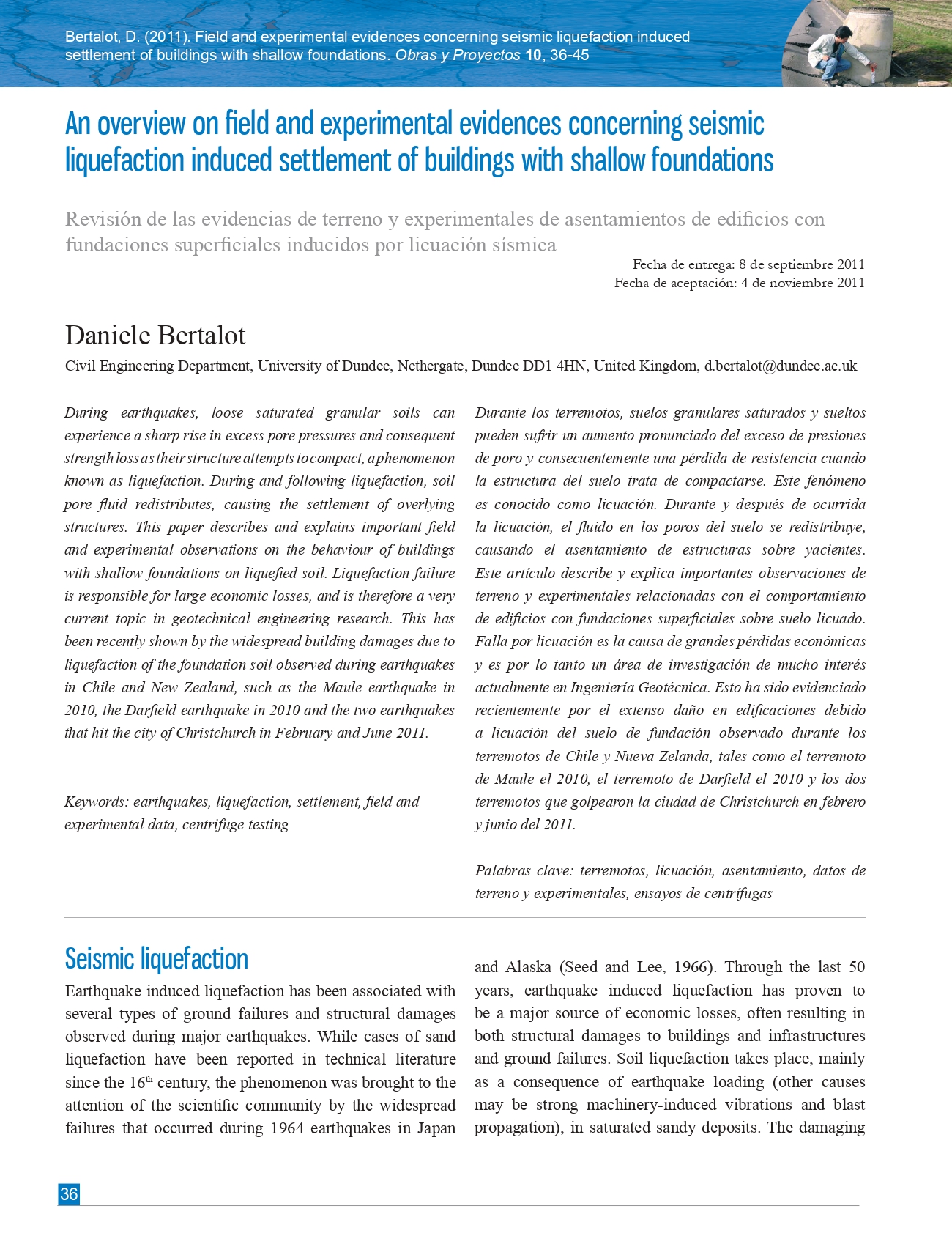An overview on field and experimental evidences concerning seismic liquefaction induced settlement of buildings with shallow foundations
DOI:
https://doi.org/10.4067/S0718-28132011000200004Keywords:
earthquakes, liquefaction, settlement, field and experimental data, centrifuge testingAbstract
During earthquakes, loose saturated granular soils can experience a sharp rise in excess pore pressures and consequent strength loss as their structure attempts to compact, a phenomenon known as liquefaction. During and following liquefaction, soil pore fluid redistributes, causing the settlement of overlying structures. This paper describes and explains important field and experimental observations on the behaviour of buildings with shallow foundations on liquefied soil. Liquefaction failure is responsible for large economic losses, and is therefore a very current topic in geotechnical engineering research. This has been recently shown by the widespread building damages due to liquefaction of the foundation soil observed during earthquakes in Chile and New Zealand, such as the Maule earthquake in 2010, the Darfield earthquake in 2010 and the two earthquakes that hit the city of Christchurch in February and June 2011.
References
Acacio, A., Kobayashi, Y., Towhata, I., Bautista, R. T. and Ishihara, K. (2001). Subsidence of building foundation resting upon liquefied subsoil: case studies and assessment. Soils and Foundation 41(6), 111-128. https://doi.org/10.3208/sandf.41.6_111
Adachi, T., Iwai, S., Yasui, M. and Sato, Y. (1992). Settlement and inclination of reinforced-concrete buildings in Dagupan-City due to liquefaction during the 1990 Philippine Earthquake. Proceedings of the 10th World Conference on Earthquake Engineering, Vol. 1, 147-152.
Dashti, S., Bray J. D., Pestana, J. M., Riemer, M. and Wilson, D. (2010). Mechanism of seismically induced settlement of buildings with shallow foundation on liquefiable soil. Journal of Geotechnical and Geoenvironmental Engineering ASCE 136(1), 151-164. https://doi.org/10.1061/(ASCE)GT.1943-5606.0000179
EERI (1995). The Hyogo-ken Nanbu (Kobe) earthquake, January 17, 1995: Preliminary Reconnaissance Report, 116p
Fiegel, G.L. and Kutter, B.L. (1994). Mechanism of liquefaction for layered soils. Journal of Geotechnical and Geoenvironmental Engineering ASCE 120(4), 737-755. https://doi.org/10.1061/(ASCE)0733-9410(1994)120:4(737)
Ghalandarzadeh, A. and Khaki Khatibi, A.R. (2003). Study on the behaviour of shallow foundations during liquefaction and mitigation methods by means of 1g shaking table tests. Proceedings BGA International Conference on Foundations, Dundee, 331-340.
Hausler, E. A., (2002). Influence of ground improvement on settlement and liquefaction: a study based on field case history evidence and dynamic geotechnical centrifuge tests. Ph.D. thesis, University of California Berkeley.
Ishihara, K. and Yoshimine, M. (1992). Evaluation of settlements in sand deposits following liquefaction during earthquakes. Soils and Foundations 32(1), 173-188. https://doi.org/10.3208/sandf1972.32.173
Liu, L. and Dobry, R. (1992). Centrifuge study of shallow foundation on saturated sand during earthquakes. Proceedings of the 4th U.S.A. -Japan Workshop on Earthquake Resistant Design of Lifeline Facilities and Countermeasures for Soil Liquefaction, Honolulu, 493-508.
Liu, L. and Dobry, R. (1997). Seismic response of shallow foundation on liquefiable sand. Journal of Geotechnical and Geoenvironmental Engineering ASCE 123(6), 557-567. https://doi.org/10.1061/(ASCE)1090-0241(1997)123:6(557)
Seed, B. and Lee, K.L. (1966). Liquefaction of saturated sands during cyclic loading. Journal of Soil Mechanics and Foundation Division 92, SM6, 105-134. https://doi.org/10.1061/JSFEAQ.0000913
Seed, H.B. and Idriss, I.M. (1971). Simplified procedures for evaluating soil liquefaction potencial. Journal of Soil Mechanics and Foundation Division 97, SM9, 1249-1273. https://doi.org/10.1061/JSFEAQ.0001662
Tokimatsu, K. and Seed, B. (1987). Evaluation of settlements in sand due to earthquake shaking. Journal of Geotechnical Engineering Division ASCE 113, No.8, 861-878.
Tokimatsu, K., Kuwayama, S., Abe, A., and Midorikawa, S. (1994). Liquefaction-induced damage to buildings in 1990 Luzon earthquake. Journal of Geotechnical and Geoenvironmental Engineering ASCE 120(2), 290-303. https://doi.org/10.1061/(ASCE)0733-9410(1994)120:2(290)
USGS (2006). Photographic library. http://libraryphoto.cr.usgs.gov/
Whitman, R.V. and Lambe, P.C. (1982). Liquefaction: consequences for a structure. Proceedings of the Conference on Soil Dynamics and Earthquake Engineering. Rotterdam, 941-949
Yoshimi, Y. and Tokimatsu, K. (1977). Settlement of buildings on saturated sands during earthquakes. Soils and Foundations 17(1), 23-28. https://doi.org/10.3208/sandf1972.17.23

Downloads
Published
Issue
Section
License
Copyright (c) 2011 Universidad Católica de la Santísima Concepción

This work is licensed under a Creative Commons Attribution-NonCommercial 4.0 International License.







